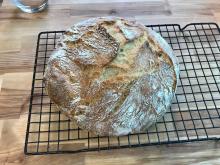Versatile Italian White Bread
Recipe courtesy of Louisiana Kitchen & Culture
Makes 2 1½ pound loaves
|
Biga
Final Dough
|
Versatile Italian White Bread Click image to enlarge |
Biga
Measure the flour into a large mixing bowl. Pour a little of the water into a small bowl and add the yeast; let sit for a minute, stir, and add to flour. Pour remaining water into the flour (or swirl some of it in the yeast bowl if any grains are stuck) and combine, either by hand or with a dough whisk. Make sure no dry flour is left in the bottom of the bowl. Cover tightly and set aside for 12 to 14 hours; assuming a room temperature 65-70ºF, the biga will have tripled in volume and be slightly domed.
Final Dough
Measure the flour into a large mixing bowl and add the salt and yeast; combine. Add the water and mix, either by hand or with a dough whisk, just until flour is incorporated.
Wet one hand and use it to ease the biga out of its container and add it to the new mixture. Keep one hand wet and mix biga into the new mixture; use your hand as a pincer, pinching through the dough several times then rotating the bowl 90 degrees and repeating, until the two doughs are well combined. (The fresh dough will be markedly warmer than the biga; it’s mixed when there are no large pockets of cold or warm dough left.)
Cover and set aside for 30 minutes, then fold the dough (this helps gluten develop, making the dough stronger; it’ll get a better rise in the baking process): Wet one hand and gently loosen dough from mixing bowl. Reach underneath the dough and grab about ¼ of the dough; pull it up until you feel resistance, then fold it over the top of the dough. Rotate the bowl about ¼ turn; repeat the process 4 or 5 times, working around the dough until it has tightened into a ball. Grab the entire ball and invert it, so that it is in the bowl seam-side down. Cover and set aside for 30 minutes, then repeat the process; cover and set aside for 30 minutes, then repeat the process 1 final time. Cover and set aside for 60 to 90 minutes in a warm spot, or until the dough is about triple the size it was after the biga was incorporated into the fresh dough.
Now divide the dough: Flour your hands and gently ease the dough out onto a floured work surface. With more flour on your hands, gently shape the dough into a somewhat even shape. Sprinkle the area to be cut with flour, then use a knife or dough scraper to divide the dough in half.
If you’re going to bake both loaves at once, shape each into a tight ball (a Google search will yield video on how to do this if you’re not familiar) and transfer, seam-side down, to proofing bowls (well-floured wicker, or kitchen bowls roughly the size of your Dutch oven lined with cotton tea towels that have been generously floured) seam-side down. Cover and set aside for about 1 hour, or until the dough springs back slowly when poked with a floured finger.
If you’re not going to bake both loaves, after dividing the dough, put half into a bowl, cover tightly, and refrigerate for up to 48 hours. To bake, let sit at room temperature 30 minutes, shape as directed, and proceed).
During this final proof, put your Dutch ovens and lids in the oven and preheat oven to 475ºF. If you only have 1 Dutch oven, refrigerate 1 loaf about 20 minutes before the bread goes in the oven; bake the first loaf and reheat the Dutch oven for about 5 minutes after removing the first loaf.
To bake, invert the proofed loaf onto a lightly floured surface (the seam side will now be facing up). Carefully remove the Dutch oven, remove the lid, and carefully drop the loaf into the Dutch oven seam side up. Cover and bake for 30 minutes, then uncover and bake for 20 to 30 minutes, until medium to dark brown. Remove it from the oven and carefully tilt the pan to turn the loaf out; place it on a wire rack and let it cool for at least 30 minutes before slicing.
Louisiana Recipes Weekly
|
Every Thursday you'll receive new recipes, events & festivals and more. See archive |







